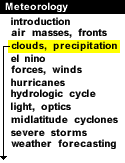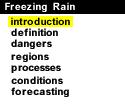
|
Freezing rain, also known as glaze, is rain that becomes supercooled and freezes upon impact with cold surfaces. Freezing rain forms when warm moist air flows over cold air at the surface. Ice storms, caused by the accumulation of freezing rain, can be the most devastating of winter weather phenomena. Ice storms cause automobile accidents, power outages, personal injuries, and they are costly to utility companies. A severe ice storm can paralyze a city.
 |
Freezing rain is difficult to forecast because, the accumulation of ice can vary greatly from one surface to another and from one place to the next. A change of only one degree fahrenheit can lead to total devastation or just plain rain. |
Sleet is sometimes confused with freezing rain. Sleet are frozen raindrops that bounce upon impact with the ground or other objects. In some areas of the world, sleet may refer to a mix of freezing rain, rain, snow or hail. Sleet are also known as ice pellets.
This educational module gives a basic overview of freezing rain. The overview includes dangers, regions, processes, conditions, forecasting, and a basic section on sleet.
|
Sections Latest Update: 07/07/97 |
Dangers
Dangers and destruction associated with ice-storms.
Regions
Processes
Conditions
Forecasting
Sleet
|
|





